By Merav Schejtman-Gilai
The rapid development of electronics and computerization in the mid 20th century, and
the invention of the digital scales, crowded out, almost entirely the use of mechanical scales.
Because of this, the mechanical scales became collectors’ items. Most mechanical scales are works of art, and are hand crafted. The work is precise and gives an authentic feel of the era in which they were created.
Types of Mechanical Scales
Equal Arm Beam Balances
The simplest type of balance, the equal-arm, or beam, balance has been used for many thousands of years as 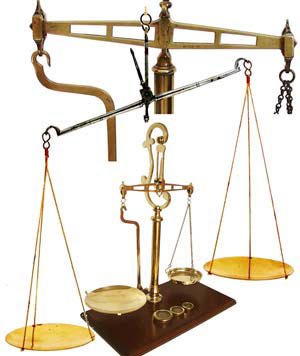 an application of a simple lever. The Beam, Fulcrum and Pointer. A uniform bar, the beam, is suspended at its exact center on a knife-edge hinge set at right angles to it. This point of support is called the fulcrum. Two pans of equal weight are suspended from the beam, one at each end, at points equally distant from the fulcrum. Since the center of gravity of a uniform bar is at its midpoint, the beam supporting the pans will be in equilibrium when it is exactly horizontal. A pointer attached at right angle to the beam at the fulcrum indicates zero on a scale when the beam is at rest parallel to a level surface. It shows also the extent of swing of the beam on one side or the other, acting somewhat as a pendulum, when the beam is coming to rest. The object to be weighed is placed on one pan, and standard weights are added to the other until the balance of the beam is established again. The unknown weight can then be determined by adding up the standard weights in the pan. Sensitivity. The sensitivity of the scales depends on 3 main factors: a) the amount of friction in the different hinges. The less friction there is, the more sensitive the scale. The knife-edged fulcrum serves this purpose. B) The total mass of the different parts of the scale. This is probably the reason for using brass to construct various parts of the scales. C) The length of the main beam.
an application of a simple lever. The Beam, Fulcrum and Pointer. A uniform bar, the beam, is suspended at its exact center on a knife-edge hinge set at right angles to it. This point of support is called the fulcrum. Two pans of equal weight are suspended from the beam, one at each end, at points equally distant from the fulcrum. Since the center of gravity of a uniform bar is at its midpoint, the beam supporting the pans will be in equilibrium when it is exactly horizontal. A pointer attached at right angle to the beam at the fulcrum indicates zero on a scale when the beam is at rest parallel to a level surface. It shows also the extent of swing of the beam on one side or the other, acting somewhat as a pendulum, when the beam is coming to rest. The object to be weighed is placed on one pan, and standard weights are added to the other until the balance of the beam is established again. The unknown weight can then be determined by adding up the standard weights in the pan. Sensitivity. The sensitivity of the scales depends on 3 main factors: a) the amount of friction in the different hinges. The less friction there is, the more sensitive the scale. The knife-edged fulcrum serves this purpose. B) The total mass of the different parts of the scale. This is probably the reason for using brass to construct various parts of the scales. C) The length of the main beam.
Modifications of Equal arm scales. Equal arm scales and balances were made for many different usage such as weighing money, gold silver and diamonds, grocery, postal parcels, chemicals etc. The details of each scale were modified and adapted to its specific use. These adaptations involved inventing new ideas that changed the classical form of Equal Arm beam. An example of such modification is the Roberval Scales: In order to place the scales on a table and lessen the friction, a mathematician called M. Gilles de Roberval invented in 1730 scales with two main beams and load platforms located on top of the beams, one at each end. These scales had two central hinges, which lessened the stress on the main hinge by half, and the precision grew immensely. Manufacturing Roberval scales with the pans above the beam started only at the beginning of the 19th century. This development allowed the scales to be placed on a table or shelf and therefore simplify the weighing process. These types of scales caught on very fast and were soon seen in market stalls and post offices.
Money Scales
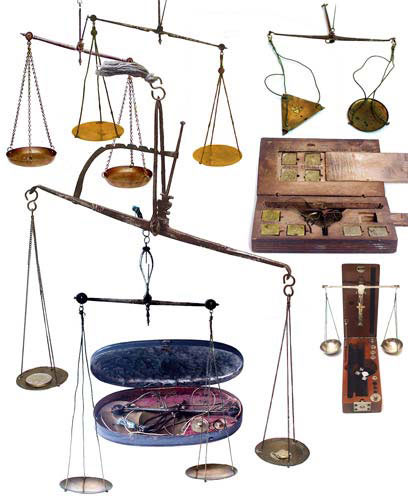 The weighing of money has been practiced since biblical
The weighing of money has been practiced since biblical
times. Weighing coins of gold or silver is known from the Roman times.
Scales for this purpose had to be accurate on the one hand and small enough to be easily trasported from one place to another, on the other.
Most money scales, therefore, have their own, usually, fitted, metal or wood containers. Most money scales were equal arm balances, but steelyard type were quite common as well. (see coin verification, bellow)
Postal Scales
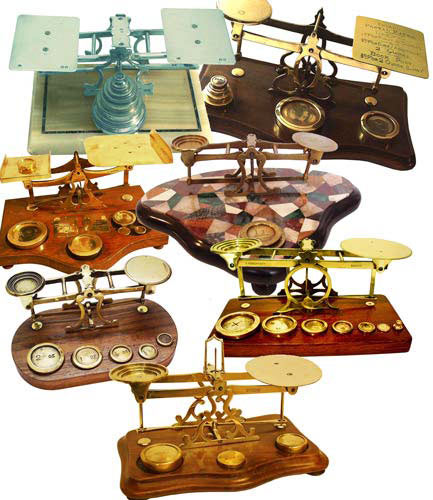
The most popular scales among collectors are postal scales.
As of 1840, the practice of adding stamps to letters and packages was established.
The amount of payment due was based on the weight of the letter.
Nearly all types of scales were used as postal scales:
Scales with the pans hanging bellow the central beam, scales with the pans placed above the central beam, spring scales, pendulum scales and more.
Kitchen Scales
These scales were used mainly for measuring quantities of ingredients used for
precise cooking. They were usually table spring- scales. The range that these scales
could weigh was usually small. Special attention was given to their design, which were
used as a decorative item as well as a functional one.
Apothecary and Analytical Scales
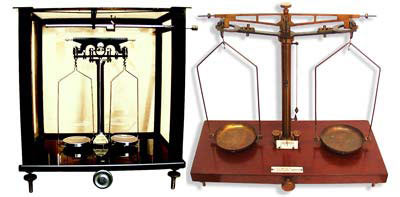 Scales that were very precise and sensitive first came into use only in the 18th century. These equal arm scales were used by doctors, pharmacists, and chemists that made
Scales that were very precise and sensitive first came into use only in the 18th century. These equal arm scales were used by doctors, pharmacists, and chemists that made
their own medicines and concoctions.
Analytical scales are characterized by their delicate central beam and small pans, usually made of glass or brass. In order to attain maximum accuracy, great pains were taken to lessen the friction of the hinges Usually one finds these scales built into a box, which incorporates a level and screws for finetuning. They are usually kept in a glass case, since their accuracy is easily affected by dust and moisture.
Unequal Arm Balances
Steelyard and Bismar Balance Scales
Steelyards are lever balances with unequal beam arms and an immovable axis (fulcrum).
A hook or 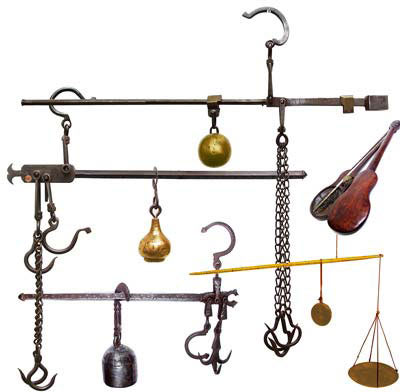 pan is attached to the shorter arm for holding the load. Another hook attached to a second fulcrum is used for holding or hanging the steelyard. Weighing the load requires that a counterpoise weight is moved along the long arm. At the place where the counterpoise keeps the beam exactly horizontal, the weight of the object is indicated on an engraved scale on the long arm. The advantage of this type of scale is that only one weight is used for a wide range of loads. To increase the range of weights that a steelyard can weigh, a modification was introduced in which a third fulcrum with hanging hook was added to the beam. This modification changes the ratio of length between the short and long arms of the beam and requires a different weight-scale to be engraved on the beam. Another modification exists in which a second counterweight is placed on the shorter arm, allowing deducting the empty container weight (tare weight) from the load, to obtain net weight. The steelyard was very common in medical clinics for weighing humans, in warehouses for weighing large loads, and also in large bridge scales for weighing trucks and trains. Since the difference in length of the arms can multiply the effect of the smaller weight by a factor of 100 or more, a small steelyard hung from a tree can be used, for example, to weigh a heavy side of beef.
pan is attached to the shorter arm for holding the load. Another hook attached to a second fulcrum is used for holding or hanging the steelyard. Weighing the load requires that a counterpoise weight is moved along the long arm. At the place where the counterpoise keeps the beam exactly horizontal, the weight of the object is indicated on an engraved scale on the long arm. The advantage of this type of scale is that only one weight is used for a wide range of loads. To increase the range of weights that a steelyard can weigh, a modification was introduced in which a third fulcrum with hanging hook was added to the beam. This modification changes the ratio of length between the short and long arms of the beam and requires a different weight-scale to be engraved on the beam. Another modification exists in which a second counterweight is placed on the shorter arm, allowing deducting the empty container weight (tare weight) from the load, to obtain net weight. The steelyard was very common in medical clinics for weighing humans, in warehouses for weighing large loads, and also in large bridge scales for weighing trucks and trains. Since the difference in length of the arms can multiply the effect of the smaller weight by a factor of 100 or more, a small steelyard hung from a tree can be used, for example, to weigh a heavy side of beef.
Another type of unequal arm beam scales are the Bismar scales which have a fixed pan or hook attached to one arm for the load and a fixed weight on the other arm. However, the central axis (fulcrum) in Bismar scales can be moved along the beam to obtain equilibrium.
Chinese “Opium” Scales are also a type of steelyard.
They have one pan suspended from an unequal ivory arm, and a brass weight for counterbalance. A load is put on the pan and then the weight is moved a long the arm until the scale is balanced. These scales are usually found inside a wooden box, with the distinctive shape of a fish or violin. These scales originated in China and were first mentioned in western literature in the 17th century, as Dotchin scales. They were used to weigh silver, gold, gems, and medicinal powders.
Pendulum Scales
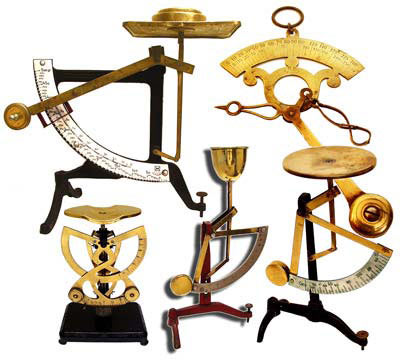 These scales are usually small and delicate. They have a lever beam with a long arm shaped like a pendulum on which a counterweight load is
These scales are usually small and delicate. They have a lever beam with a long arm shaped like a pendulum on which a counterweight load is
permanently attached. The shorter arm is connected to a pan or hanger for the load to be weighted. Placing the load on the balance cases
the pendulum arm to swing laterally together with an indicator that shows the precise weight of the load. There are different types of pendulum scales
for different purposes. An interesting invention was made in which two different counterweights are attached to a single pan, crating a bilateral scale in which the range of weighing capacity has been doubled.
Coin Verification Scales
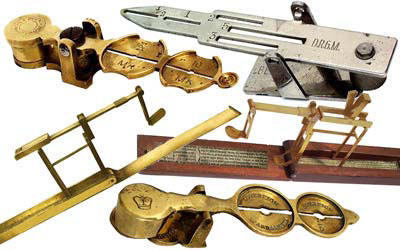 Verifying the correct weight of gold and silver coins is an age old practice. The weighing was done on very precise scales,
Verifying the correct weight of gold and silver coins is an age old practice. The weighing was done on very precise scales,
but until the beginning of the 18th century, it was possible to verify one ounce with maximum precision of only 0.1 grams.
With an aim at improving the accuracy and sensitivity of the scales, their mass was lightened and the hinges were improved. Many new small scales were invented.
In 1770, pocket scales were introduced.
The scales were inside a box. Inside the box were small equal arm scales for weighing a small coin.
In 1817 with the introduction of the gold Sovereign the rocker balance was invented. These scales were balanced only if the weight of the coin was exact. It was also possible to verify the diameter and the thickness of a coin using these same scales. As of 1860, the minting of coins was much improved so that forging was nearly impossible. After a while, the merchants stopped using these types of scales, and shortly after, their production stopped completely.
Textile and Paper Scales
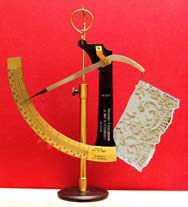 Different textiles and paper vary in their weight per square unit. So in the beginning of the 19th century special scales were invented. The results they gave were not in units of weight but in weight pertaining to area (ounce to square inch)
Different textiles and paper vary in their weight per square unit. So in the beginning of the 19th century special scales were invented. The results they gave were not in units of weight but in weight pertaining to area (ounce to square inch)
Merchants dealing in paper or textile used to carry these scales with them to determine the quality and standard of the wares.
Grain Scales
In every flourmill and grain silo, there are special scales (Chondrometers) for weighing
the grain. The weight of the grain is one of the more important factors in its quality. The
scales were equal arm balances, but instead of pans, there were copper cylinders of a
known weight and volume. When the cylinders were filled with grain, the resulting
weight was in weight pertaining to volume (pound to gallon).
Spring Scales
In 1698, Christof Weigel of Germany described a new kind of scale, which has no pans or weights, but uses a
spring. From that period onward many types of spring scales were invented, among them:
The weight of an object is determined by monitoring the deformation in an elastic material (usually a metal spring) caused by the object that is being weighed. The
degree of deformation is indicated by a pointer on a scale, which is part of the instrument.
The most common spring scale is a cylinder into which a spring is inserted. The spring can be pulled by hanging the load beneath it or compressed by putting
the load on top of it. The change in the spring length is used to estimate the weight. A spring balance cannot retain its accuracy permanently; the spring gradually uncoils even though its limit of elasticity has not been exceeded.
Mancur Scales
There are two types of Mancur Scales: The sector, or V-spring Scale and the C-Spring Scale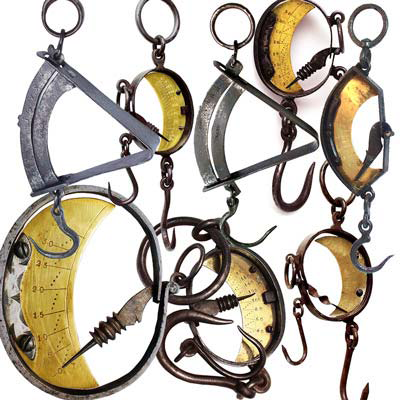 The Mancur sector, or V-spring scale is probably the first type of Mancur scales to have been in production around 1750. It was made of hard iron without screws and was used for weighing hide or meat. The spring mechanism of the sector type is ingenious in its simplicity: A load was put onto the hook, when the spring was pulled open by the load, the indicator moved upwards by the separation of the two ends of the spring. The indicator is a crescent-shaped plate marked with 5 divisions. The weight of the load is read on the indicator as it passes through a slot. The production of the elaborate more common type, the C scale, started some 25 years after the V scale. This type was used in Europe as well as in the Unites States in the 19th century. The scale is made by forging an elliptical steel spring stripe, suspension rings, load hooks, and a brass dial plate with graduations. A C type scale can one hook or two hooks and to different graduation scales.
The Mancur sector, or V-spring scale is probably the first type of Mancur scales to have been in production around 1750. It was made of hard iron without screws and was used for weighing hide or meat. The spring mechanism of the sector type is ingenious in its simplicity: A load was put onto the hook, when the spring was pulled open by the load, the indicator moved upwards by the separation of the two ends of the spring. The indicator is a crescent-shaped plate marked with 5 divisions. The weight of the load is read on the indicator as it passes through a slot. The production of the elaborate more common type, the C scale, started some 25 years after the V scale. This type was used in Europe as well as in the Unites States in the 19th century. The scale is made by forging an elliptical steel spring stripe, suspension rings, load hooks, and a brass dial plate with graduations. A C type scale can one hook or two hooks and to different graduation scales.
Egg Scales
Egg scales were needed for sorting the eggs according to size. Most egg scales were
spring scales. The earlier models, in which each egg was weighed separately, were
based on a springy metal strap with a spoon like depression on top. Later scales were
built that could weigh simultaneously a large number of eggs and sort them
accordingly. There were a great many designs and methods of construction and,
although they were of little aesthetic merit, their technical quaintness gave them great
charm.
Epilogue
The bible mentions numerous accounts of weighing. In Genesis chapter 23, Abraham wishes to purchase from Ephron the Hittite a burial cave called Machpelah (vs. 8-19), so that he can bury his wife Sarah.
Ephron says to Abraham: “The land is worth four hundred silver Shekels, but what can this be between me and thee?” “…And Abraham weighed to Ephron the silver…” “So the field of Ephron… were made sure unto Abraham for a possession…” This is the first purchase of commodities that is mentioned in the Bible, which uses weighing.
Bibliography
1. Kirsch Bruno, Scales and Weights. Yale Studies in the History of Science and medicine. Yale Univ. Press. 1965
2. Turner Gerald, Scientific Instruments 1500-1900 University of California Press. 1998
3. Mechira Pumbit Magazine Vol. 20. 2000.















 Print
Print